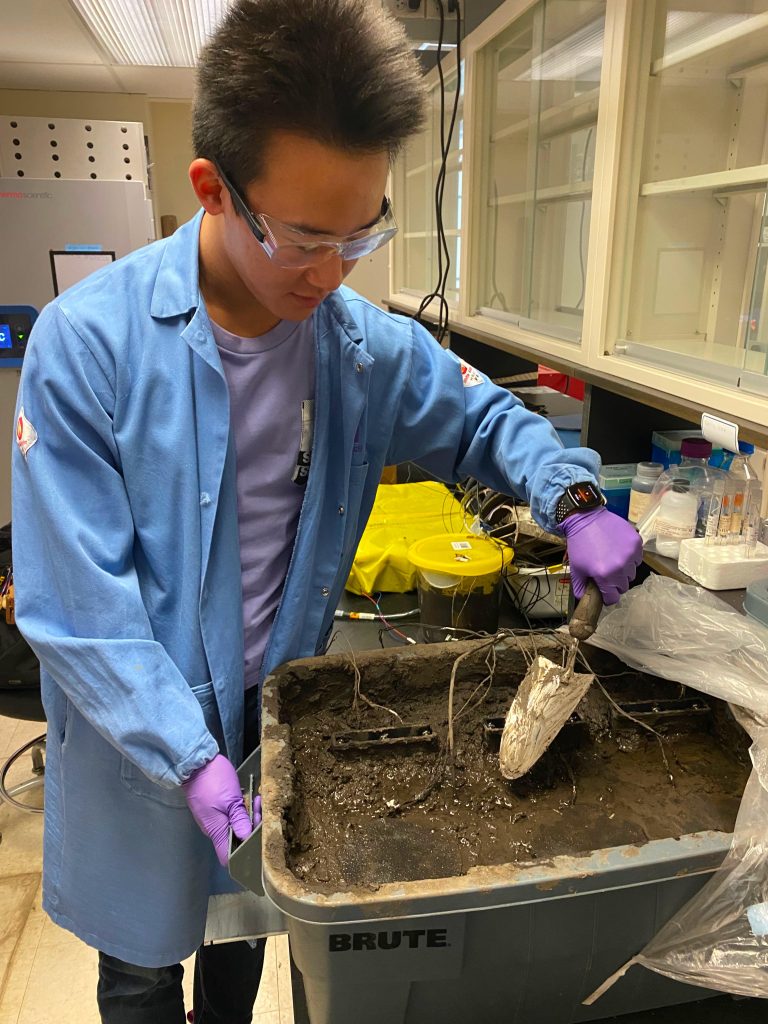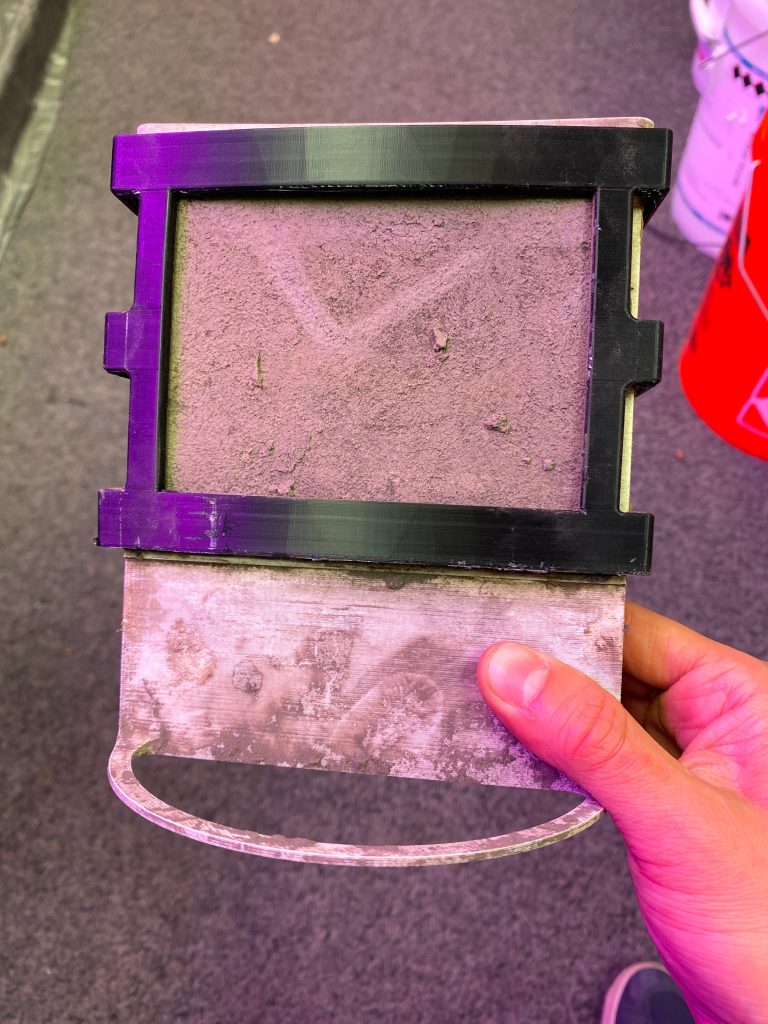Researchers from Northwestern University have introduced a fuel cell powered by soil microbes, significantly outperforming similar technologies and providing a sustainable solution for powering low-power devices, with full public access to their designs for widespread application. The 3D printed fuel cell lid peeks out above the ground. The cover keeps debris out of the device while enabling airflow. Credit: Bill Yen/Northwestern University
A team of researchers led by Northwestern University has developed a new fuel cell that harvests energy from microbes living in dirt.
About the size of a regular paper book, the soil-based technology could power underground sensors used in precision agriculture and green infrastructure. This potentially provides a sustainable, renewable alternative to batteries, which contain toxic and flammable chemicals that leach into the ground, are fraught with conflict-ridden supply chains, and contribute to the ever-growing e-waste problem.
To test the new fuel cell, the researchers used it to power sensors that measure soil moisture and detect touch, a capability that could be valuable for tracking passing animals. To enable wireless communications, the researchers also equipped the soil-based sensor with a small antenna to transmit data to a nearby base station by reflecting existing radio frequency signals.
Not only did the fuel cell perform in wet and dry conditions, but its power also exceeded similar technologies by 120%.
The research will be published today (January 12) in the Proceedings of the Association for Computing Machinery on Interactive, Mobile, Wearable, and Ubiquitous Technologies. The study authors also make all designs, tutorials, and simulation tools public, so others can use and build on the research.
“The number of devices connected to the Internet of Things (IoT) is constantly growing,” said Bill Yen, a Northwestern University graduate student who led the work. “If we imagine a future with trillions of these devices, we won't be able to build every one of them using lithium, heavy metals and toxins that pose a risk to the environment. We need to find alternatives that can provide low amounts of energy to power a decentralized network of devices. In our search for solutions , we looked at soil microbial fuel cells, which use special microbes to break down the soil and use that low amount of energy to power sensors. As long as there is organic carbon in the soil for the microbes to break down, the fuel cell can potentially last forever.

Bill Yen, the study's lead author, buried the fuel cell during testing in the laboratory at Northwestern University. Credit: Northwestern University
“These microbes are everywhere. They actually live in the soil everywhere,” said George Wells of Northwestern University, a senior author on the study. “We can use very simple engineering systems to get electricity. We will not supply entire cities with this energy. But we can capture tiny amounts of energy to power practical, low-power applications.
Wells is an associate professor of civil and environmental engineering at Northwestern's McCormick School of Engineering. Now a Ph.D. Yin, a student at Stanford University, began this project while he was an undergraduate researcher in Wells' lab.
Solutions for a dirty job
In recent years, farmers around the world have increasingly adopted precision agriculture as a strategy to improve crop yields. The technology-based approach relies on measuring precise levels of moisture, nutrients and pollutants in the soil to make decisions that promote crop health. This requires a large and dispersed network of electronic devices to continuously collect environmental data.
“If you want to put a sensor out in the wilderness, or on a farm, or in a wetland, you're limited to putting a battery in it or harvesting solar energy,” Yen said. “Solar panels don't work well in dirty environments because they're covered in dirt, they don't work when the sun's not out, and they take up a lot of space. Batteries are also a challenge because they run out of power. Farmers won't walk around a 100-acre farm regularly replacing batteries or dusting panels Solar.
To overcome these challenges, Wells, Wayne and their collaborators wondered if they could instead harvest energy from the existing environment. “We can harvest energy from the soil that farmers are monitoring anyway,” Yen said.
'Frustrated efforts'
Making their debut in 1911, soil-based microbial fuel cells (MFCs) operate like a battery – with an anode, cathode and electrolyte. But instead of using chemicals to generate electricity, MFCs collect electricity from bacteria that naturally donate electrons to nearby conductors. When these electrons flow from the anode to the cathode, they form an electrical circuit.

The fuel cell is covered with dirt after being extracted from the ground for studies. Credit: Bill Yen/Northwestern University
But for microbial fuel cells to operate uninterrupted, they need to remain moist and supplied with oxygen, which is difficult when they are buried underground in dry dirt.
“Although MSCs have been around as a concept for more than a century, their unreliable performance and low production capacity have frustrated efforts to make practical use of them, especially in low-humidity conditions,” Yin said.
Winning engineering
With these challenges in mind, Yin and his team embarked on a two-year journey to develop a practical and reliable soil-based MFC cell. His journey included creating – and comparing – four different versions. First, the researchers collected nine months of data on the performance of each design. They then tested their final version in an outdoor park.
The best-performing prototype performed well in dry conditions as well as in a submerged environment. The secret behind its success: its engineering. Instead of using the traditional design, where the anode and cathode are parallel to each other, the winning fuel cell made use of an orthogonal design.
Made of carbon felt (a readily available and inexpensive conductor for capturing microbe electrons), the anode is horizontal to the ground. The cathode consists of an inert, conductive metal and is placed vertically above the anode.
Although the entire device is buried, the vertical design ensures that the upper end is flush with the ground surface. There is a 3D printed cover on top of the device to prevent debris from falling inside. The hole at the top and the empty air chamber running next to the cathode allow a constant flow of air.
The lower end of the cathode remains positioned deep below the surface, ensuring that it remains moist from the surrounding wet soil, even when the topsoil dries in sunlight. The researchers also coated part of the cathode with a waterproofing material to allow it to breathe during flooding. After a potential flood, the vertical design enables the cathode to dry gradually rather than all at once.
On average, the resulting fuel cell generated 68 times more power than was needed to operate its sensors. It was also robust enough to withstand large changes in soil moisture – from somewhat dry (41% water by volume) to completely underwater.
Making computing accessible to everyone
All components of soil-based MFC can be purchased at a local hardware store, researchers say. Next, they plan to develop a soil-based MFC made of fully biodegradable materials. Both designs bypass complex supply chains and avoid the use of conflict minerals.
“With the Covid-19 “We have all become familiar with how the crisis has disrupted the global electronics supply chain,” said study co-author Josiah Hester, a former faculty member at Northwestern University who now works at the Georgia Institute of Technology. “We want to build devices that use local supply chains and low-cost materials so that computing is accessible to all communities.”
Reference: “Soil-Powered Computing” by Bill Yen, Laura Gleave, Luis Gutierrez, Veluthi Sahinidis, Sadie Bernstein, John Madden, Steven Taylor, Colin Josephson, Pat Panuto, Weitao Shuai, George Wells, Nivedita Arora, and Josiah Hester, January 11 . 2024, Proceedings of the ACM on Interactive, Mobile, Wearable, and Ubiquitous Technologies.
doi: 10.1145/3631410
The study was supported by the National Science Foundation (Award No. CNS-2038853), the Agricultural and Food Research Initiative (Award No. 2023-67021-40628) of the USDA National Institute of Food and Agriculture, the Alfred P. Sloan Foundation, VMware Research, and 3M.

“Typical beer trailblazer. Hipster-friendly web buff. Certified alcohol fanatic. Internetaholic. Infuriatingly humble zombie lover.”
